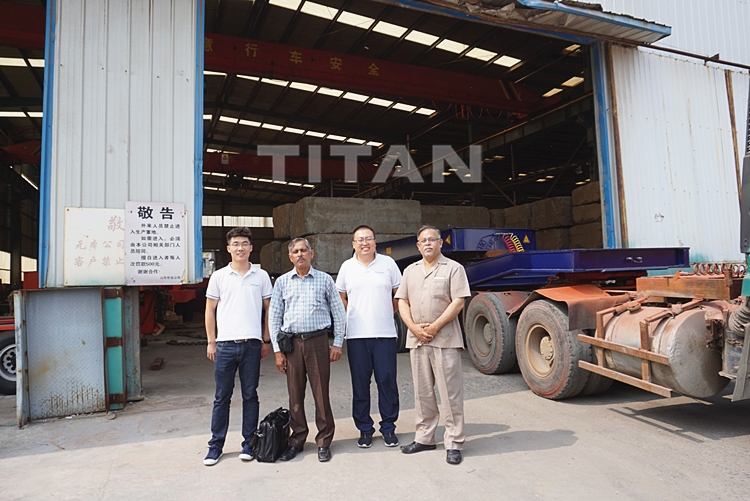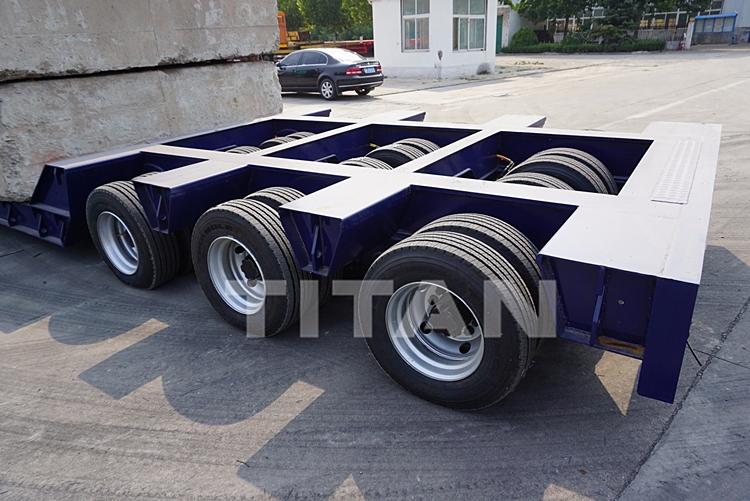1. During normal inspection, the low bed truck trailer needs to be in an empty state.
2. When the wheel is to be lifted, the axle should be lifted at the same time, and the jack position should be near the leaf spring.
3. The parts in contact with the jack should be covered with thick steel plates or planks to prevent local stress or slipping.
 Customers visits our factory and buys 3 line 6 axle low bed truck trailer
Customers visits our factory and buys 3 line 6 axle low bed truck trailer
When the brake is working, check whether the brake cylinder push rod moves flexibly and whether it is within the specified stroke (standard working stroke is 30 ~ 35mm). If the stroke exceeds 50mm, it should be adjusted.
In the braking state, check the brake air chamber for air leaks. Apply soapy water to the clamps to check for air leaks. If the air leaks, tighten the clamp clamping nuts with a tightening torque of 30 N.m. Check the front vent hole for air leaks. If air leaks, replace the rubber diaphragm. Inspect the exterior for cracks and damage, and replace the entire brake cylinder if necessary.
After driving, be sure to open the water drain valve at the bottom of the gas reservoir to drain the internal condensate. Turn the water valve for a few seconds to completely drain the internal condensate.
During the drainage, the internal gas will be discharged at the same time. If too much exhaust gas causes the emergency relay valve to act, the gas should be replenished to maintain the pressure in the gas cylinder at its prescribed pressure.
 100 ton low bed truck trailer axlex and tires
100 ton low bed truck trailer axlex and tires
Inspect the axles, wheels and tires for cracks, damage and deformation, and repair or replace if necessary.
1. Check the traction pin for flaws, premature wear and cracks every day.
2. Measure the diameter of the traction pin. If the diameter is less than 48 or 86mm, it should be replaced if there is a crack or abnormal damage.
3. When the traction pin is changed or the traction pin is loose, the traction pin lock nut should be tightened, and the tightening torque is 1100 ~ 1300N.m.
4. Check the traction pin seat plate for damage, distortion and foreign matter, and repair or replace if necessary.
1. Check if the terminal is slack, whether the wire is sagging and damaged, and repair or replace if necessary.
2. Inspect the car lights. If there are broken filament bulbs, lamp housing cracks and surface gloss damage, etc., they should be replaced.
1. Check the traction seat panel for weld cracks and wear plates for severe wear.
2. Check whether the lock hook, wear ring and cross bolt are severely worn, deformed or loose.
3. Check whether the bolts of the support base and the connecting plate are loose, and whether the support base is damaged.
4. Check whether the rubber damping sleeve is damaged. The method is to use a crowbar to pry the joint between the saddle plate and the support seat. If the gap is large, the rubber shock-absorbing sleeve has been damaged.
5. Check whether the safety lock works normally and whether the lever mechanism is flexible or stuck.
Welcome to click “Resource“, you can get more article about our trailers.
Click “Product“, you can find your favorite semi trailer.
And welcome to leave your question in the message box below, thanks!